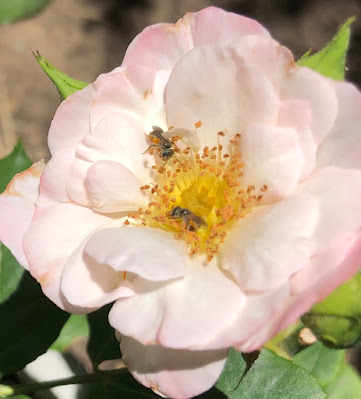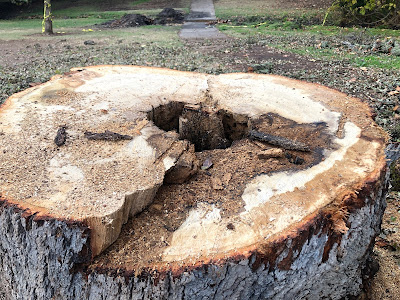
Many native species sleep in the soil

|
|
During spring and summer, sweat bees such
as these can be seen foraging on many
blooming plants. (Photos: Kathy Morrison)
|
Mulch is a wonderful thing, and we have lots of free mulch falling from our trees now. But please don't cover every inch of the garden with it. The native bees we've worked so hard to entice to our plants need some bare soil.
Many California species -- and there are about 1,600 native bee species -- nest underground. Honeybees, which are not native, live in hives, of course. Native carpenter bees do what they're named for: carve holes in fence posts and other wood for their nests.
But other bees are solitary. Smaller than honeybees, sometimes tiny, they nest in soil holes barely the width of a pencil lead, usually in flat, sunny spots. Some bee species nest in already-existing cavities or holes.
I was able to see ground-nesting bees up close earlier in the year when I was adding new chip mulch around my rose bushes. Suddenly 5 or 6 little bees appeared, hovering in a rather agitated manner. I scraped back the chips they were flying over and, sure enough, there were little holes in the ground near the base of one bush. I found other tiny holes at the edge of the same planting area, near the driveway. I watched one bee crawl into its hole.
Now I'm more cautious about what I cover up, and am careful to leave some areas uncovered in each planting bed. (Note: Mulch shouldn't come right up against stems or trunks anyway, since that can promote rot.)
Now, leaf mulch or leaf litter does offer protection for bumble bee queens, and butterfly and moth species, as well as that gardener favorite, the lady beetle. So do leave some leaves!
Pollinators may go into hibernation when the weather turns colder, but they don't go away entirely. And we want them back in spring.
(For more on pollinators and winter, check out this excellent post from the Xerces Society.)
A postscript on an oak tree

|
|
This is the remaining stump from the blue oak that
lost its leader branch in late October.
|
Sure enough, it's been cut down to the final few feet of its 4-foot-wide trunk. I peeked at the stump and wasn't surprised to see the center rotted out. We're probably lucky that the branch fell when it did, rather than the entire tree falling down and taking out a lot of the nearby trees and the utility building next to it -- and potentially harming park visitors.
But I will miss this tree.
Comments
0 comments have been posted.Sacramento Digs Gardening to your inbox.
Sites We Like
Garden Checklist for week of July 21
Your garden needs you!
* Keep your vegetable garden watered, mulched and weeded. Water before 8 a.m. to reduce the chance of fungal infection and to conserve moisture.
* Feed vegetable plants bone meal, rock phosphate or other fertilizers high in phosphate to stimulate more blooms and fruiting. (But wait until daily high temperatures drop out of the 100s.)
* Don’t let tomatoes wilt or dry out completely. Give tomatoes a deep watering two to three times a week.
* Harvest vegetables promptly to encourage plants to produce more. Squash especially tends to grow rapidly in hot weather. Keep an eye on zucchini.
* Pinch back chrysanthemums for bushy plants and more flowers in September.
* Remove spent flowers from roses, daylilies and other bloomers as they finish flowering.
* Pinch off blooms from basil so the plant will grow more leaves.
* Cut back lavender after flowering to promote a second bloom.
* It's not too late to add a splash of color. Plant petunias, snapdragons, zinnias and marigolds.
* From seed, plant corn, pumpkins, radishes, winter squash and sunflowers.